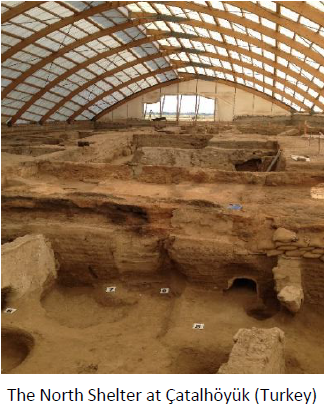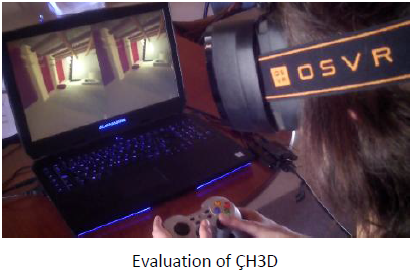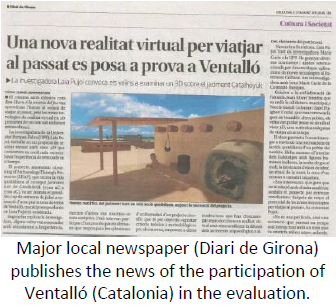Summary
In one {LEAP]
One of the main goals of Virtual Heritage is currently to build 3D architectural reconstructions of archaeological sites for their dissemination. However, thanks to the immersive and interactive character of VR, it may also allow a more direct understanding of the culture that lived there. This overlaps in part with the concept of Cultural Presence, presented some years ago in the field of Human-Computer Interaction (HCI), but never fully investigated.
The two-year EU-funded project {LEAP] (LEarning of Archaeology through Presence), conceived and conducted by Dr Laia Pujol-Tost, aimed to develop this crossroad area by researching, implementing and evaluating a new interdisciplinary theoretical and methodological framework for Archaeology. The idea behind the project was that Cultural Presence (the feeling of “being then and there”) was the key to design and evaluate experiences that would enhance understanding, social relevance and enjoyment of Cultural Heritage.
{LEAP]ing at opportunities
 Such ambitious, highly interdisciplinary endeavour could only be achieved by means of a collaboration between strong research teams. At Pompeu Fabra University in Barcelona, the Department of Humanities and CMTech Lab joined forces to merge Archaeology, the Cognitive Sciences and HCI.
Such ambitious, highly interdisciplinary endeavour could only be achieved by means of a collaboration between strong research teams. At Pompeu Fabra University in Barcelona, the Department of Humanities and CMTech Lab joined forces to merge Archaeology, the Cognitive Sciences and HCI.Later on, Çatalhöyük Research Project entered the team, as the investigations would be based on the Neolithic settlement of Çatalhöyük (Turkey). With its closely-built mud-brick houses, the mother-goddess figurines, the in-house burials and the innovative archaeological approach adopted to uncover them, this impressive archaeological site, declared World Heritage by UNESCO in 2012, has become a reference both for the expert community as well as non-expert audiences.
A {LEAP] into the dark
{LEAP] was developed in three phases. Firstly, a theoretical and methodological framework based on a new understanding of Cultural Presence was built and successively reviewed and refined with the help of relevant scientific literature.

The second step was the design and implementation of a VR-mediated experience of Çatalhöyük. “ÇH3D” was built with 3D Studio Max and Unity Game Engine. To define the content, a mixture of traditional and innovative methods (adapted from co-design and multimodal analysis) was used. Because it requires light equipment (gaming laptop, HMD, earphones and gamepad), it can be experienced anywhere. The user experience consists of a one-day trip to Çatalhöyük 9000 years ago. It has two display modes, immersive and screen-based, which increase flexibility regarding audiences and environments. The model has 6 different versions (architecture only, objects, hotspots, still characters, scenes, and storytelling). In each one, users can explore 5 pre-defined points of interest (2 inside a house and 3 at different points on the settlement) displaying the most representative cultural aspects of Çatalhöyük. For test purposes, different levels of visual realism were introduced.

In the third stage, the cognitive, emotional and learning impact of ÇH3D was evaluated. To that end, a Cultural Presence Questionnaire (CPQ) was built and pilot-tested after an exhaustive review of Presence assessment tools. 85 participants (from 12 to 80 years-old, skilled and unfamiliar with VR technology and Cultural Heritage) explored ÇH3D while being recorded, and filled in two questionnaires (before and after the experience). The subsequent qualitative and quantitative analyses provided the first comprehensive results about learning in virtual reconstructions.
The {LEAP] forward
The main contributions of the {LEAP] Project are the following:
1. Building a new research area. The proposal of Cultural Presence as an empirically grounded theoretical and methodological framework should help develop the currently under-theorized area of Virtual Heritage.
2. Providing new, verified, trans-disciplinary tools and methods for design and assessment. The Co-design Method for VR-mediated experiences (3DCoD) and the Cultural Presence Questionnaire (CPQ) need to be tested in other contexts, but they could become in the next five years standard tools for Virtual Heritage.
3. Setting new models. ÇH3D intended to set a revolutionary model for the representation of the past: instead of 3D architectural models, a phenomenological VR-mediated experience; instead of static photorealism, a general feeling of dynamic verisimilitude (as in videogames); instead of simulation of reality, enhancement of virtuality (to facilitate understanding).
4. Providing guidelines: the comparative evaluation of ÇH3D in its different versions complements the above with a set of empirically supported guidelines for the design of different kinds of virtual reconstructions according to specific, explicit goals.
5. Contributing to other research areas: true to its interdisciplinary character, {LEAP] has also delivered new statistical data about the factors underlying (Cultural) Presence and its (positive) correlations with learning that can be added to the HCI field.
2016 was a… {LEAP] year!
 To ensure the maximum quality and significance of the project outputs, the researcher held periodic meetings and consultations with different researchers, stakeholders and companies in Spain and abroad by means of the {LEAP] User Group. On the other hand, to ensure maximum impact, she planned and is still carrying out a wide range of scientific dissemination and outreach activities to raise awareness about the suitability of Cultural Presence and the related tools (CPQ, 3DCoD) to make Virtual Heritage more relevant in society.
To ensure the maximum quality and significance of the project outputs, the researcher held periodic meetings and consultations with different researchers, stakeholders and companies in Spain and abroad by means of the {LEAP] User Group. On the other hand, to ensure maximum impact, she planned and is still carrying out a wide range of scientific dissemination and outreach activities to raise awareness about the suitability of Cultural Presence and the related tools (CPQ, 3DCoD) to make Virtual Heritage more relevant in society.{LEAP] was also an amazing professional experience for Dr Laia Pujol-Tost. The MSCA fellowship provided an incredible opportunity to acquire new skills, firstly, by means of selected courses and workshops. Yet, the most important training was to face the everyday challenges of managing a research project, to build practically a VR interactive experience, and to coordinate a heterogeneous international team. This was possible by means of a Secondment with two expert VR professionals, Ms. Hara Sfyri and Mr Dimitris Christopoulos, from the renowned Foundation of the Hellenic World in Athens.
My gratefulness to them and to all the people who {LEAP]t in along these two years to make this project possible!
